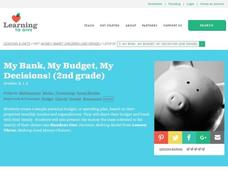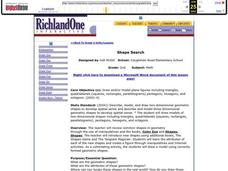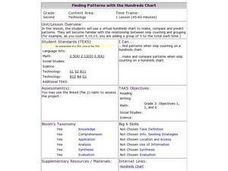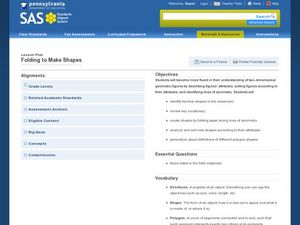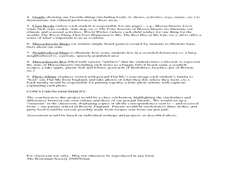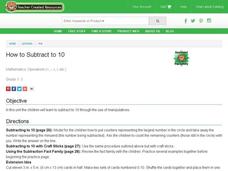Curated OER
Less is More: Subtraction in Action
Students participate in group games to help review the concept of subtraction. During the games, they practice subtracting two-digit numbers and the concept of borrowing. They review their answers with the class and move on to...
Curated OER
Fraction Reaction
Students review how to solve problems with fractions. In groups, they participate in a card game in which they identify the fraction and its equivalent. They also complete a worksheet related to fractions and have a partner check their...
Curated OER
Measuring Weight, Mass, and Capacity
Second graders measure weight, mass, and capacity. In this measurement instructional activity, 2nd graders model how to measure amounts of liquid by using containers that measure one cup, one pint, and one quart. Students compare the...
Curated OER
Making Good Money Choices
Student explore an economic-decision making model to decide where to donate money they have collected. In this philanthropic money lesson, students develop a plan for raising money and then decide how to best spend it for the most...
Curated OER
My Bank, My Budget, My Decisions
Students create a personal budget. In this financial planning lesson, students create a budget using income data and identify ways to save a portion of money for donations.
Curated OER
Caldecott Medal Winners
Second graders identify Caldecott Medal winners. In this library media lesson, 2nd graders view an overhead transparency of Caldecott Medal winners from 1987-2004 and answer questions based on the data that is displayed.
Curated OER
Get Ready, Get Set, Squeeze!
Students explore coin value and count coin combinations. In this money counting and social studies lesson, students read The Coin Counting Book by Rozanne Lanczak Williams and practice counting money and making change for a lemonade...
Curated OER
How tall are you?
Students review different units of measurement that would be used to measure height. They compare their height to that of Abraham Lincoln by working with a partner to make a life size tracing of each other and measuring their height.
Curated OER
Money Madness
Second graders review coins and their values. In this coin recognition instructional activity, 2nd graders review the coin values as they read 'Smart' by Shel Silverstein. Students use class computer demonstrations to identify the coin's...
Pennsylvania Department of Education
Links Away: Looking Back and Moving Forward
Students explore fact families. In this math lesson, students use links to model a fact family. Students solve addition and subtraction problems.
Curated OER
Algebraic Processes And Its Connections To Geometry
Youngsters explore number patterns within a Hundreds Chart. They discover six specific patterns from six teacher-directed rules in cooperative groups and describe in words ONE of the three patterns in their Learning Logs. They prove for...
Curated OER
Poems: calligrams
Have fun with shape poems! First and second graders write calligrams that add to the meaning of their poems. Great for your poetry unit or if you want to combine poetry and art lessons.
Curated OER
Estimation Using Goldfish Crackers: Math
Second graders explore estimation and rounding concepts using goldfish crackers and a song! They solve problems by estimating and rounding numbers and pick numbers within reason to represent certain objects.
Curated OER
Fractions
Second graders, while in the computer lab discuss Fraction Action by Loreen Leedy, practice solving problems involving fractions. They explore non-unit fractions by describing parts of a set utilizing their attributes to categorize the...
Curated OER
Spatial Connections
Students use maps, scales, and describe locations in order to learn about spatial sense. In this spatial sense lesson plan, students participate in many activities for this spatial sense unit that should last throughout the year.
Curated OER
Shape Search
Second graders draw a model using correctly formed geometric shapes. In this geometric shapes lesson, 2nd graders notice geometric shapes in the world around them and accurately draw these shapes.
Curated OER
How Much is that Name?
Students explore money counting. In this money problem solving lesson, students calculate how much money their name is "worth" using the corresponding alphabet letters which have been assigned a coin value.
Curated OER
Spud Stuff
Student culminate a unit on potatoes. In this potato lesson, young scholars make a booklet using the information acquired throughout a unit. They draw a picture of their potato, name it, measure it in inches, count its eyes, weigh their...
Curated OER
Finding Patterns with the Hundreds Chart
Students review their numbers up to one hundred. Using a chart, they compare and predict patterns that might be in the numbers. They practice skip counting and grouping numbers. Using a spreadsheet, they graph different sets of numbers...
Curated OER
Folding to Make Shapes
Second graders identify different polygons and their attributes. In this geometry lesson, 2nd graders get to know polygons by studying the vocabulary and finding polygons in their classroom. They create these shapes and then find their...
Curated OER
Out of Old England in the 1630s-Flat Me Project
Learners write letters to penpals. In this geography/literacy lesson, students become penpals with a classroom in England to learn about customs and society across the ocean. Flat Stanley by Will Holton is read aloud, and learners...
Curated OER
Origami Ducks: Geometry, Listening, and Following Directions
Make origami ducks with your class to reinforce geometry concepts and vocabulary; develop fine motor and visual translation skills; and enrich study of Japanese culture, the pond habitat, or migration. Create a whole group "worksheet"...
Curated OER
Telling Time as an Everyday Use of Numbers
How can we estimate time? Have your young mathematicians make a clock. Then they compare and contrast types of clocks. They practice writing times in two different ways and make a book about telling time.
Curated OER
How to Subtract to 10
Students subtract to 10 through the use of manipulatives. They will use craft sicks and the fact family on their practice pages. They examine how subtracting one always uses the larger number first.




